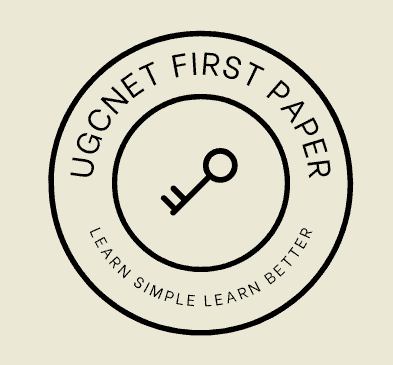तर्क रूप (Argument forms)
तर्क प्रपत्र विशिष्ट संरचनाएं या पैटर्न हैं जो तर्कों में परिसर और निष्कर्ष के बीच तार्किक संबंधों का प्रतिनिधित्व करते हैं। ये फॉर्म यह समझने के लिए एक रूपरेखा प्रदान करते हैं कि किसी विशेष दावे का समर्थन या औचित्य साबित करने के लिए विभिन्न प्रकार के तर्कों का उपयोग कैसे किया जाता है। यहां कुछ सामान्य तर्क प्रपत्र दिए गए हैं:
1. मोडस पोनेन्स:
– यदि ए, तो बी.
– एक।
– इसलिए, बी.
यह तर्क प्रपत्र दावा करता है कि यदि एक निश्चित स्थिति (ए) सत्य है और यह एक विशिष्ट परिणाम (बी) की ओर ले जाती है, और हम जानते हैं कि स्थिति सत्य है, तो हम आत्मविश्वास से निष्कर्ष निकाल सकते हैं कि परिणाम भी सत्य होना चाहिए।
2. मोडस टोलेंस:
– यदि ए, तो बी.
– बी नहीं है।
– इसलिए, ए नहीं.
मोडस टॉलेंस तर्क का एक रूप है जो विरोधाभास द्वारा काम करता है। यदि अपेक्षित परिणाम (बी) नहीं होता है, तो हम अनुमान लगा सकते हैं कि प्रारंभिक स्थिति (ए) भी गलत है।
3. काल्पनिक न्यायवाक्य:
– यदि ए, तो बी.
– यदि बी, तो सी.
– इसलिए, यदि ए, तो सी।
इस तर्क प्रपत्र में दो सशर्त कथन शामिल हैं और पहले कथन के पूर्ववृत्त को दूसरे कथन के परिणाम के साथ जोड़कर निष्कर्ष निकाला जाता है।
4. विघटनकारी न्यायवाक्य:
– ए या बी.
– ए नहीं.
– इसलिए, बी.
डिसजंक्टिव सिलोगिज़्म में, दो विकल्पों में से एक को खारिज कर दिया जाता है, जिससे यह निष्कर्ष निकलता है कि दूसरा विकल्प सत्य होना चाहिए।
5. रचनात्मक दुविधा:
– या तो एक या बी।
– यदि ए, तो सी.
– यदि बी, तो डी.
– इसलिए, या तो C या D.
रचनात्मक दुविधा एक ऐसी स्थिति प्रस्तुत करती है, जहां, चाहे ए या बी सत्य हो, सकारात्मक परिणाम (सी या डी) होता है। इसका उद्देश्य यह दिखाना है कि कोई भी विकल्प वांछनीय परिणाम की ओर ले जाता है।
6. विनाशकारी दुविधा:
– या तो एक या बी।
– सी नहीं।
– यदि ए, तो सी.
– यदि बी, तो डी.
– इसलिए, डी नहीं.
विनाशकारी दुविधा भी ए और बी के बीच एक विकल्प प्रस्तुत करती है लेकिन इसका उद्देश्य यह दिखाना है कि विकल्पों में से एक अवांछनीय परिणाम (डी) की ओर ले जाता है।
तार्किक तर्क के निर्माण और विश्लेषण दोनों के लिए इन तर्क रूपों को समझना मूल्यवान है। इन पैटर्नों को पहचानने से व्यक्तियों को तर्कों की वैधता का आकलन करने, भ्रांतियों की पहचान करने और अधिक प्रभावी आलोचनात्मक सोच और संचार में संलग्न होने में मदद मिलती है। इसके अतिरिक्त, यह अकादमिक सेटिंग्स में औपचारिक तर्क और तर्क-वितर्क का अध्ययन करने के लिए एक आधार प्रदान करता है।
Argument forms
Argument forms are specific structures or patterns that represent the logical relationships between premises and conclusions in arguments. These forms provide a framework for understanding how different types of reasoning are used to support or justify a particular claim. Here are some common argument forms:
1. Modus Ponens:
– If A, then B.
– A.
– Therefore, B.
This argument form asserts that if a certain condition (A) is true and it leads to a specific consequence (B), and we know that condition is true, then we can confidently conclude that the consequence must also be true.
2. Modus Tollens:
– If A, then B.
– Not B.
– Therefore, not A.
Modus Tollens is a form of argument that works by contraposition. If the expected consequence (B) does not occur, then we can infer that the initial condition (A) is also false.
3. Hypothetical Syllogism:
– If A, then B.
– If B, then C.
– Therefore, if A, then C.
This argument form involves two conditional statements and draws a conclusion by connecting the antecedent of the first statement with the consequent of the second statement.
4. Disjunctive Syllogism:
– A or B.
– Not A.
– Therefore, B.
In a disjunctive syllogism, one of the two options is ruled out, leading to the conclusion that the other option must be true.
5. Constructive Dilemma:
– Either A or B.
– If A, then C.
– If B, then D.
– Therefore, either C or D.
Constructive dilemma presents a situation where, regardless of whether A or B is true, there is a positive outcome (C or D). It aims to show that either choice leads to a desirable result.
6. Destructive Dilemma:
– Either A or B.
– Not C.
– If A, then C.
– If B, then D.
– Therefore, not D.
Destructive dilemma also presents a choice between A and B but aims to show that one of the options leads to an undesirable consequence (D).
Understanding these argument forms is valuable for both constructing and analyzing logical reasoning. Recognizing these patterns helps individuals assess the validity of arguments, identify fallacies, and engage in more effective critical thinking and communication. Additionally, it provides a foundation for studying formal logic and argumentation in academic settings.
- भारत-पाक सीमा पर तनाव: दोहरे बम विस्फोटों में 20 की मौत, क्या टूट जाएगा युद्धविराम?
- Narendra Modi Salary
- क्रांति गौड़ – बॉल गर्ल से वर्ल्ड कप तक
- multilingual-text-extractor
- Script Swapper
- भारत-पाक सीमा पर तनाव: दोहरे बम विस्फोटों में 20 की मौत, क्या टूट जाएगा युद्धविराम?
- Narendra Modi Salary
- क्रांति गौड़ – बॉल गर्ल से वर्ल्ड कप तक
- multilingual-text-extractor
- Script Swapper
